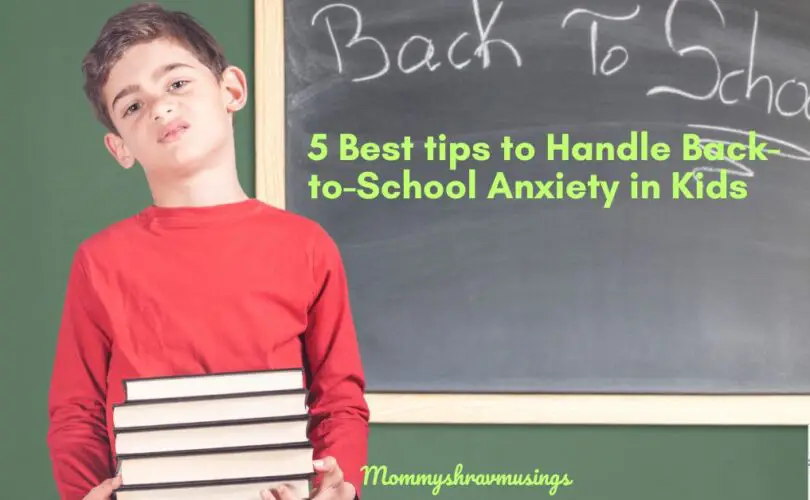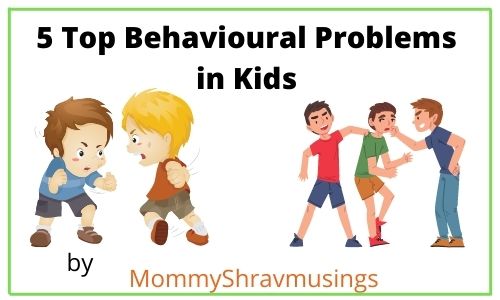The end of summer vacation marks the beginning of a new school year, a time filled with excitement, opportunities, and the promise of growth. However, it also brings back-to-school anxiety in kids, a common but manageable challenge affecting children of all ages. Whether it’s the butterflies in the stomach of a kindergartener entering a new world or the performance pressure a high school student feels, back-to-school anxiety can be daunting.
But fear not! In this guide, we will unveil some of the best strategies to help children of various age groups conquer their back-to-school jitters and step confidently into the world of learning. From preschoolers taking their first steps into the classroom to high schoolers gearing up for college applications, these tips are designed to ease the transition and make the return to school a smooth and positive experience. So, let’s dive in and discover how we can empower your kids to embrace the new school year with enthusiasm and confidence!

Why do some kids have Back-to-School Anxiety?
Back-to-school anxiety is a term used to describe the feelings of unease, nervousness, or stress that some individuals, particularly students, experience as they prepare to return to school after a break, such as a summer vacation or a holiday break. This anxiety can manifest in various ways and affect individuals of all ages, from young children to adults returning to school or college.
Let me talk about my son’s anxiety to make it easier to understand why this happens to most kids. Some kids can manage it by themselves, but some may require help from their parents or caregivers.
The night before the first day of school, my child finds it difficult to fall asleep. He worries about unknown stuff that might happen in the school tomorrow. He likes to follow a routine, and he is concerned whether his friends will remain as friendly as last year, if his new teacher will be nice, etc.
The following day, he will be anxious and withdrawn. He wouldn’t even touch the breakfast, as he felt he wouldn’t be able to stomach the breakfast. His anxiety will reach its peak when he reaches the school gate. He thinks that he can’t face the uncertainty and challenges that awaits in the classroom. His anxiety gradually subsided throughout the day as he became engrossed in the classroom activities and reconnected with his friends.
This scenario illustrates how back-to-school anxiety can manifest in children, causing emotional distress and physical symptoms. Here are some common reasons why kids across different age groups may experience back-to-school anxiety:
1. Separation from Parents: Younger children, particularly preschool and kindergarten-aged kids, may experience anxiety due to the separation from their parents or caregivers. They have often spent significant time at home, and returning to school involves leaving the comfort of home and loved ones.
2. Fear of the Unknown: Starting a new school year or transitioning to a new grade can bring uncertainty. Children may worry about not knowing their teachers and classmates or what to expect academically, socially, or routines.
3. Academic Pressure: Elementary school children and older may experience anxiety related to academic performance. They may worry about the workload, tests, grades, and meeting academic expectations.
4. Social Concerns: Social anxiety can be a significant factor, especially in middle and high school. Children and teenagers may fear making new friends, fitting in, or dealing with peer pressure and bullying.
Do you know that bullying can cause Social Anxiety in Kids?
5. Changes in Routine: Transitioning from the flexibility of summer to the structured school routine can be challenging for kids of all ages. They may have concerns about waking up early, managing homework, and balancing extracurricular activities.
6. Peer Relationships: Adolescents may experience heightened anxiety about peer relationships, including worries about being accepted, having conflicts with friends, or experiencing loneliness. Past negative experiences at school, such as bullying or academic difficulties, can sometimes contribute to anxiety.
7. Fear of Failure: Children and teens may be anxious about failing or not meeting their own or their parents’ expectations, leading to performance anxiety. High school is the right time for students to plan for their future, including college or career choices, which makes them anxious about their performance.
It’s essential to recognize that back-to-school anxiety is a normal response to change and uncertainty. However, suppose this anxiety becomes severe, persistent, or significantly interferes with a child’s ability to function. In that case, it may be advisable to seek the help of a mental health professional, such as a child psychologist or counselor.

Tips to help with back-to-school anxiety in Kids across different age groups:
Here are some tips to help children across different age groups cope with this anxiety:
Preschool and Kindergarten (Ages 3-5):
- Familiarize Them with the School: Visit the school before the first day if possible. Show them around, including the classroom, playground, and bathrooms. Familiarity can reduce anxiety.
- Establish a Routine: Create a consistent daily routine that mimics the school schedule. This can help children feel more comfortable with the structure of the school day.
- Talk Positively About School: Use positive language when discussing school. Highlight the fun aspects of learning and socializing with new friends.
- Meet the Teacher: If you can, arrange a meeting with the teacher before the school year starts. This can help your child feel more comfortable.
- Social Skills Development: Teach basic social skills like sharing, taking turns, and making friends. These skills can help ease social anxiety.
Elementary School (Ages 6-11):
- Open Communication: Encourage your child to express their feelings and concerns about school. Create a safe space for them to talk openly.
- Prepare Together: Involve your child in back-to-school preparations like shopping for supplies and picking out clothes. This can give them a sense of control.
- Gradual Adjustment: Start transitioning to a school schedule a few weeks before the first day. Gradually adjust bedtime and wake-up times.
- Set Realistic Expectations: Talk about what to expect academically and socially. Acknowledge that it’s okay to make mistakes and that learning can be challenging.
- Stay Involved: Attend back-to-school events and parent-teacher meetings. Being involved in your child’s school life can provide reassurance.
Are your children worried about the mean girls at school? Here are some tips to handle them effectively.
Middle School (Ages 12-14):
- Organization Skills: Help your child develop good organizational skills, including using a planner, keeping track of assignments, and managing time.
- Respect Independence: Recognize that middle schoolers crave more independence. Give them space to make decisions and solve problems on their own.
- Stay Connected: Keep lines of communication open, but respect their need for privacy. Ask about their day, but don’t press if they’re not ready to talk.
- Peer Relationships: Discuss friendship dynamics and the importance of choosing friends who support and respect them.
- Support Self-Care: Encourage healthy habits like exercise, a balanced diet, and sufficient sleep, as these can help reduce stress.
High School (Ages 15-18):
- Goal Setting: Help your teenager set realistic academic and personal goals for the school year. This can provide motivation and a sense of purpose.
- Time Management: Teach time management and study skills. High school students often face increased academic demands.
- College and Career Planning: Discuss post-high school plans and guide college applications at the earliest and provide them the confidence that you are there to support them.
- Stress Management: Teach stress-reduction techniques such as mindfulness, deep breathing, and exercise.
- Encourage Independence: Allow your teenager to take ownership of their education and decision-making while providing guidance and support when needed.
Remember that each child is unique, and their anxiety levels may vary. Be patient, empathetic, and responsive to their individual needs as you help them navigate back-to-school anxiety. If anxiety persists or worsens, consider consulting with a child psychologist or counselor for additional support.
When should parents start worrying about this anxiety?
Parents should be attentive to their child’s back-to-school anxiety and provide support as needed. While some level of anxiety is expected during this transition, certain signs may indicate a need to consult with experts or seek professional help. Here are some tips on when parents should consider taking such action:

- Prolonged and Severe Symptoms: If a child’s back-to-school anxiety is severe, persistent, or lasts for several weeks into the school year, it’s a sign that the anxiety may be more than just a typical adjustment phase.
- Physical Symptoms: If anxiety is causing significant physical symptoms such as frequent stomachaches, headaches, sleep disturbances, or other somatic complaints, it may be time to consult a healthcare professional or mental health specialist.
- Avoidance Behavior: If a child consistently refuses to attend school, has a strong aversion to school-related activities that disrupt their daily life, has difficulty making friends, or exhibits signs of social withdrawal, this is cause for concern.
- Regression: If a child exhibits regressive behaviors such as bedwetting, thumb-sucking, or excessive clinginess that they have outgrown, it may be related to unresolved anxiety. Drastic changes in mood, such as extreme irritability, anger outbursts, or unexplained tearfulness, can be signs of underlying emotional distress.
- Self-Harm or Suicidal Thoughts: If a child expresses thoughts of self-harm or suicide, it is a critical emergency, and immediate professional intervention is essential. Contact a mental health crisis line or seek help from a mental health specialist or therapist.
When parents observe one or more of these signs or are unsure about the severity of their child’s back-to-school anxiety, they should consult with a mental health professional, such as a child psychologist, counselor, or psychiatrist. These experts can conduct assessments, provide guidance, and offer appropriate interventions to address the child’s anxiety and emotional well-being. Early intervention can be crucial in helping children overcome their anxiety and thrive in the school environment.
Here are some positive affirmations for your teen to make them super confident.
Parting Thoughts:
In the whirlwind of back-to-school preparations, it’s essential to remember that the back-to-school anxiety kids experience during this time is a normal response to change and transition. While it can be challenging, it’s also an opportunity for growth, resilience, and valuable life lessons.
As parents and caregivers, we play a pivotal role in helping our children navigate the waters of back-to-school anxiety. Hope you liked the tips to handle back-to-school anxiety in kids. If you have any other tips, please do share them here for the benefit of other parents.
QOTD: Ask your children – Do they feel anxious about attending school at the start of the academic year.

Suhasini, IP, is the Author of the book “Practical Tips for Kids Mental Health.” As a certified kids and parents life coach, she helps/guides you toward a happy family life for your kids. She firmly believes that “Emotionally Happy Kids of today are the Mentally Strong and Happy Citizens of tomorrow.” Let’s make the world a happy and beautiful place for our kids to thrive.








[…] your kids becoming anxious about school and looking for reasons to skip it? Then here are some tips for you to handle their school […]